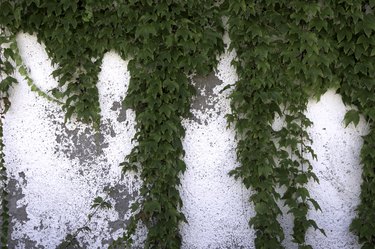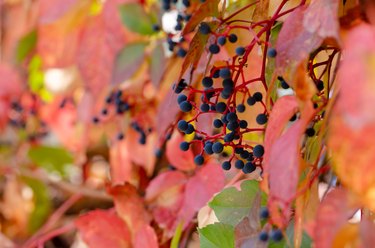
Virginia creeper (Parthenocissus quinquefolia) is a deciduous vine native to North America, ranging from the East Coast to Mexico. Propagate in late spring and early summer by taking Virginia creeper cuttings and rooting them in a moist mix. Hardy in U.S. Department of Agriculture plant hardiness zones 3 through 9, this vigorous vine is used as a ground cover and climber to cover unattractive walls and fences.
About the Virginia Creeper
Video of the Day
Virginia creeper plants' names include woodbine and Virginia-creeper. This native vine grows over the soil and clambers up fences, buildings and trees; select a location carefully because the vines can grow up to 50 feet long. While it thrives in full sun to part shade, the best fall color is obtained in full sun locations.
Video of the Day
The vines cling to slopes, fences and structures using the sucker disks on their tendril tips. While the adhesive disks and tendrils don't invade and damage siding and other wall coverings, they must be sanded or scraped from the wall surface before painting. If you must pull the vines off of a building for maintenance or painting, prune those vines back to the base of the plant. The plant will develop new vines from the roots.
New leaves are purplish, fading to green through the summer, then turning brilliant red to burgundy before they drop in fall. The inconspicuous greenish-white flowers, which appear from late spring through late summer, progress to blue-black berries enjoyed by birds and wildlife.
Take Virginia Creeper Cuttings

Take soft cuttings from the tips of the vines in late spring or early summer, when the vines are growing vigorously. Put on gloves, long sleeves and safety goggles, then sterilize the pruner blades with Lysol.
Snip a 4- to 5-inch cutting from the vine and strip the leaves from the bottom two-thirds. Swirl the cut end in rooting compound, if desired, then insert into moist sand and perlite, or potting mix. Cover the cutting and pot with a plastic bag and set in a warm, brightly lit location.
Keep the mix lightly moist by misting with water. New roots develop in 10 to 14 days. When new foliage appears, transplant the Virginia creeper cutting into a larger container or outside in the garden.
Care of Virginia Creeper Plants
Water to soak the soil to a depth of 6 inches, weekly or as needed. Add 2- to 3-inch layer of mulch over the soil to slow evaporation and discourage weed seed germination; pull it back 3 to 4 inches from the stem. Fertilize in spring by scratching a slow-release fertilizer into the soil and water thoroughly.
Prune when dormant to keep the vines within bounds. Watch for Virginia creeper pests, such as snails and slugs, aphids, beetles, scale, whiteflies and other bugs and insects. Avoid wetting the foliage to prevent fungal diseases.
Cautions and Virginia Creepers

Virginia creeper is very similar in appearance to the highly toxic poison ivy (Toxicodendron radicans), which thrives in USDA zones 3 through 10. In general, poison ivy has three leaflets, while Virginia creeper usually has five leaflets that grow up to 6 inches long.
Virginia creeper leaves may cause skin irritation in sensitive individuals. The berries are toxic, causing gastric distress, diarrhea, slow heartbeat and even death. Keep out of reach of children and pets. In addition, Virginia creeper is highly flammable; plant vines outside of your home's defensible space.
- Missouri Botanical Garden: Parthenocissus Quinquefolia
- Lady Bird Johnson Wildflower Center: Parthenocissus Quinquefolia
- North Carolina Extension Gardener Plant Toolbox: Parthenocissus Quinquefolia
- North Carolina Extension Gardener Plant Toolbox: Toxicodendron Radicans
- Yardener: Care of Virginia Creeper